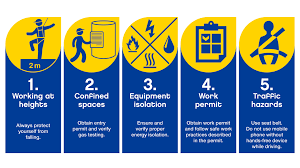The Importance of Safety Rules
Safety rules are essential guidelines put in place to protect individuals from harm and ensure a secure environment. Whether at home, work, school, or in public spaces, following safety rules is crucial for preventing accidents and minimizing risks.
Why Safety Rules Matter
Prevent Accidents: Safety rules help prevent accidents by outlining proper procedures and precautions to follow in different situations. Whether it’s wearing protective gear, using equipment correctly, or practicing fire safety measures, adhering to safety rules can significantly reduce the likelihood of injuries.
Promote Awareness: By following safety rules, individuals become more aware of potential hazards and risks in their surroundings. This heightened awareness encourages proactive behavior and helps people identify and address safety concerns before they escalate into dangerous situations.
Establish Order: Safety rules create a sense of order and discipline in various settings. They set clear expectations for behavior and actions, promoting a structured environment where everyone understands their role in maintaining safety standards.
Examples of Safety Rules
Workplace Safety: In a work environment, safety rules may include wearing personal protective equipment (PPE), following proper lifting techniques, reporting hazards promptly, and participating in safety training programs.
Road Safety: When on the road, obeying speed limits, using seat belts, avoiding distractions while driving, and following traffic signals are critical safety rules that help prevent accidents and save lives.
Home Safety: At home, safety rules may involve keeping emergency contact information handy, installing smoke alarms and carbon monoxide detectors, securing hazardous materials out of reach of children, and practicing fire escape drills with family members.
In Conclusion
Adhering to safety rules is not just a matter of compliance; it is a responsibility we owe to ourselves and those around us. By prioritizing safety in all aspects of our lives and actively following established guidelines, we contribute to creating a safer and more secure environment for everyone.
Essential Safety Rules: Top Guidelines and the #1 Rule to Follow
- What are the 7 basic safety rules?
- What are 10 safety rules?
- What are the 12 simple safety rules to follow?
- What is the #1 rule in safety?
What are the 7 basic safety rules?
When it comes to safety rules, understanding the foundational principles is crucial for maintaining a secure environment. The concept of the “7 basic safety rules” serves as a fundamental guide for individuals across various settings. These rules typically encompass key principles such as wearing appropriate personal protective equipment (PPE), following proper procedures for handling equipment, maintaining a clean and organized workspace, identifying and reporting hazards promptly, practicing good housekeeping, adhering to established emergency protocols, and participating in regular safety training programs. By internalizing and applying these core safety rules consistently, individuals can significantly reduce the risk of accidents and contribute to a safer environment for themselves and those around them.
What are 10 safety rules?
When it comes to safety rules, there are several key guidelines that individuals should always keep in mind to promote a secure environment. Some common safety rules include wearing appropriate personal protective equipment, following proper procedures for handling hazardous materials, maintaining a clean and organized workspace, practicing good housekeeping to prevent slips and falls, adhering to traffic regulations when driving or crossing the road, keeping emergency exits clear and easily accessible, reporting any potential hazards or safety concerns promptly, following proper lifting techniques to prevent back injuries, staying alert and focused while operating machinery or equipment, and participating in regular safety training programs to stay informed about best practices. By incorporating these safety rules into daily routines, individuals can help ensure their well-being and that of those around them.
What are the 12 simple safety rules to follow?
When it comes to ensuring safety in various environments, there are 12 simple safety rules that individuals can follow to minimize risks and prevent accidents. These rules encompass a range of practices, from wearing appropriate protective gear to maintaining a clean and organized workspace. By adhering to these guidelines, individuals can create a safer environment for themselves and those around them, promoting awareness, order, and proactive behavior in their daily activities. Remembering and implementing these 12 simple safety rules can significantly contribute to a culture of safety and well-being in any setting.
What is the #1 rule in safety?
The number one rule in safety is to prioritize prevention. By taking proactive measures to identify and address potential hazards before they escalate into dangerous situations, individuals can significantly reduce the risk of accidents and injuries. Prevention involves staying vigilant, following established safety protocols, and fostering a culture of safety awareness in all aspects of life. Remember, prevention is key to maintaining a safe environment for oneself and others.

